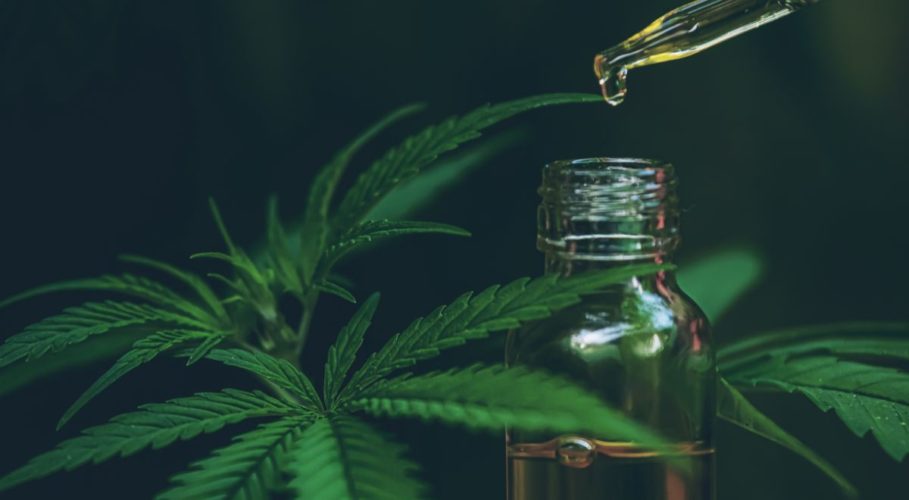Making your own CBD Oil, can seem like a daunting task.
Truth be told, most folks are intimidated by the idea of creating their own cannabis oil from scratch.
The fear is real and valid – after all, we’re talking about extracting potent cannabinoids from raw plant material. It’s not exactly baking cookies!
But here’s the kicker…
If you’ve ever wished for a more personalized approach to your wellness journey with CBD Oil, making it at home might just be the game-changer you need.
Table of Contents:
- Mastering the Art of Homemade Cannabis Oil
- The Initial Mixing Process
- Sieving Filtering Your Mixture
- Sieving and Filtering Your Mixture
- Evaporating Off Excess Alcohol Safely
- Final Steps towards Pure CBD Oil
- FAQs in Relation to Cbd Oil, How to Make Cannabis Oil at Home
- Conclusion
Mastering the Art of Homemade Cannabis Oil
The path to concocting your own cannabis oil in the home may appear complicated, but it’s easier than you’d expect. The first step is gathering all necessary ingredients and equipment.
Picking Your Plant: Choosing the Right Cannabis or Hemp Material
Selecting suitable plant material plays a pivotal role in crafting potent homemade canna-oil. Different strains yield varying effects on the final product, so choose wisely. If CBD-rich oil is what you’re after, consider using hemp plants known for their higher CBD content.
Your chosen plant matter should be properly dried and shredded before use. A good quality cannabis grinder will help achieve this consistency.
A Matter of Purity: Understanding Alcohol’s Role in Extraction Process

In addition to choosing appropriate ground cannabis or hemp material, another key ingredient required when making cannabis oils at home is alcohol – specifically one with a purity level above 60%. This food-grade alcohol acts as an extraction medium that pulls out cannabinoids like THC and CBD from decarbed cannabis efficiently.
Better-quality end-product results are achieved by using purer alcohols during extraction since they offer better cannabinoid separation capabilities. Remember only safe-for-consumption alcohols such as Everclear or pure grain alcohol should be used.
Gearing Up: Essential Tools Needed for Making Homemade Canna-Oil
Moving beyond these primary ingredients (plant matter & alcohol), there are several tools needed throughout different stages involved within the creation process:
- A plastic spoon helps ensure even distribution of heat during the stirring procedure;
- Glass bowls serve multiple purposes including mixing ingredients together & storing the finished infused oil;
- A sieve separates solid particles from the liquid extract post-stirring phase ensuring smoothness;
- Coffee filters further refine our alcoholic mix by filtering any remaining solids after sieving has been completed providing clarity essential towards preserving potency longer-term usage purposes.
All these components play integral roles ultimately leading towards successfully crafting potent personalized medicinal substances meeting specific needs individual users report having.
Key Takeaway:
Making cannabis oil at home is simpler than it seems. Key steps include choosing the right plant material, using high-purity alcohol for extraction, and having essential tools like a grinder, spoon, glass bowls, sieve and coffee filters on hand. The process involves careful preparation and patience but leads to potent personalized wellness solutions.
The Initial Mixing Process
Once all the ingredients and equipment are gathered, it’s time to start creating your own cannabis oil by blending plant material with alcohol in precise quantities. This journey begins with a crucial step: blending your plant material with alcohol.
Correctly Measuring Amounts of Plant Material & Alcohol
Your first task is to place your dried and shredded cannabis or hemp plant material in one of your glass bowls. The importance here lies in precision; an accurate scale will help measure out just enough ground cannabis for potency without overwhelming effects.
To this mixture, add cold alcohol until it fully covers the plant matter. It’s essential that you use high-proof alcohol (over 60% purity) as anything less might not extract cannabinoids effectively from raw matter. Studies suggest higher concentrations are more efficient at extracting THC and CBD – two primary active compounds found within our beloved plants.
Understanding Time Sensitivity in Stirring Procedure
This concoction needs vigorous stirring but only for three minutes exactly. Why such specificity? Prolonging this process could draw unwanted elements like chlorophyll into our oil resulting in unpleasant taste and coloration. Additionally, longer exposure to air during stirring increases chances of oxidation, leading to the degradation of essential cannabinoids we aim to preserve. Homemade Cannabis Oil Therefore, sticking strictly to timing ensures optimal extraction without compromising quality. Note: You’re double boiling decarbed heated, so be sure there’s enough ventilation as some fumes produced at this stage are quite strong.
Sieving Filtering Your Mixture
Proper Sieving Techniques
Moving forward after adequately stirred, sieve the solution into another bowl to separate larger chunks of solid particles from the cannabinoid-rich alcoholic mix, leaving a clearer liquid ready for further refinement processes. Patience is key, and good practice would be using cheesecloth instead of traditional sieves due to their finer mesh, allowing for better filtration results. Coffee filters can also effectively come in handy when aiming to achieve even cleaner extracts devoid of any remaining solids, hence highly recommended. Once the initial sieving procedure completes successfully, however, bear in mind that filtering through these takes longer given their fine nature. Again, this plays a vital role throughout the entire journey towards creating the perfect homemade cannabis oil. Remember to always handle them carefully to avoid tearing them apart and causing spillage of the valuable content inside. Now, the next step is evaporating.
Key Takeaway:
When making homemade cannabis oil, precision is key. Use high-proof alcohol to extract cannabinoids from your plant material and stir for exactly three minutes – no more, no less. Sieve the mixture carefully using cheesecloth or coffee filters for optimal filtration before moving onto evaporation.
Sieving and Filtering Your Mixture
Having completed the initial mixing process, you’re now ready to move on to sieving your cannabis plant material. This step is crucial in ensuring that larger chunks of plant matter are separated from the liquid extract.
Proper Sieving Techniques
The art of sieving involves more than just pouring your mixture into a sieve. It’s about using tools effectively and understanding how each tool contributes towards creating high-quality cannabis oil at home.
A good starting point? Use a sieve with small enough holes – this ensures solid particles don’t slip through unnoticed. Pour slowly, allowing gravity time to separate solids from liquids. If necessary, repeat until clarity improves significantly.
An extra tip: consider adding cheesecloth atop your sieve for even better results. Cheesecloth has been widely endorsed by many who’ve successfully made their own CBD oils due to its fine mesh structure which traps solids while letting only liquids pass through.
Using Coffee Filters Effectively
Coffee filters offer an additional level of refinement after sieving; they’re great at filtering out any remaining tiny particulates within our cannabinoid-rich alcoholic mix thanks to their smaller pores compared to regular kitchen strainers. Studies have shown this method helps produce cleaner extracts directly infused with raw ground cannabis plants themselves following proper dosing instructions accordingly according to potency requirements and personal preferences alike, thereby providing an optimal experience every time users consume these products, whether it be in the form of pot brownies or other delicious edibles available on the market today.
Master the art of making high-quality CBD oil at home. From sieving techniques to using coffee filters for refinement, every step matters. A pro tip? Try adding cheesecloth atop your sieve for even better results. #DIYCBDOil #CannabisWellnessClick to Tweet
Evaporating Off Excess Alcohol Safely
Making homemade cannabis oil can be a hazardous process, so taking the necessary safety precautions when evaporating off excess alcohol is essential. The key here is to remember that we’re dealing with highly flammable substances – so let’s tread carefully.
Safety Precautions during Ethanol Evaporation
To kick things off on the safe side, always ensure your workspace has proper ventilation – ideally outdoors if possible. This helps prevent accidental ignition from ethanol vapors building up within an enclosed space (CDC Safety Guidelines).
In addition to good ventilation practices, having a fire extinguisher nearby isn’t just smart; it’s essential when working with volatile materials like ethanol. And while this may sound obvious: never leave your heating device unattended.
Last but certainly not least among our precautions are personal protective equipment (PPE). Heat-resistant gloves and eye protection aren’t optional extras; they’re necessary tools for ensuring your well-being throughout this process.
Estimating Volume Reduction Accurately
Moving onto more technical aspects of our procedure now: estimating volume reduction accurately plays a crucial role in achieving high-quality cannabinoid extraction without compromising quality (NCBI study on Cannabinoids). Our goal? Reduce about 80% of initial volume which indicates most ethanol has been removed leaving behind mostly cannabinoids.
- Note down initial volume measurement before starting evaporation.
- Closely monitor level drops visually by marking bowl sides every hour or so until desired reduction achieved.
- Avoid rushing through this phase: slow and steady wins race ensuring maximum cannabinoid extraction.Tips For Effective Evaporation Process
- If available use rice cooker instead traditional stovetop methods because its automatic temperature control feature makes maintaining optimal conditions easier thereby minimizing risk over-heating thus preserving valuable cannabinoids better.
Key Takeaway:
When making cannabis oil at home, safety is paramount. Ensure good ventilation and keep a fire extinguisher handy to prevent accidents with flammable ethanol. Don’t skimp on personal protective gear – heat-resistant gloves and eye protection are must-haves. Accurate volume reduction is key for quality extraction; aim to reduce about 80% of the initial volume slowly but surely. Using a rice cooker can simplify the process by maintaining optimal conditions automatically, helping preserve those valuable cannabinoids better.
Final Steps towards Pure CBD Oil
Making a cannabis oil from scratch may appear to be an intimidating job, but with proper advice and perseverance, you can easily create THC oil or other cannabinoid-rich oils. After evaporating most of the alcohol from your mixture, there are still some crucial steps to take before enjoying your DIY product.
Determining Complete Removal Of Residual Ethanol
To ensure that all traces of ethanol have been completely removed from your cannabis-infused solution, it’s essential to heat what remains after evaporation on a coffee machine hot plate continuously for 24 hours. This process may feel lengthy but remember: good things come to those who wait.
You’re double boiling decarbed cannabis here – not just any ordinary cooking. The goal is not only about making homemade canna-oil follow these procedures; safety also plays an integral role in this step as residual ethanol could pose health risks when consumed.
Storing And Preserving Potency Of Home Made CBD OIL
The next critical aspect – proper storage cannabinoids require for maintaining their potency over time. Your freshly made batch should be stored using medical syringes under refrigerated conditions which help preserve its potency longer term usage purposes.
- Glass containers: Always store infused oil (whether coconut oil or olive-based) in glass containers rather than plastic ones since plastics tend degrade over time possibly contaminating precious liquid inside.
- Cool & Dark Place: Like how wine needs cellar keep best qualities intact same goes our DIY hemp/cannabis-infused olive/coconut etc., oils too. They love cool dark places away direct sunlight excessive heat both which cause degradation active compounds present within them leading loss efficacy long run.
- Airtight Containers: Oxygen exposure speeds up decomposition cannabinoids hence why air-tight sealing vital part proper storage regimen irrespective whether we talk about ground cannabis buds themselves ready-made pot brownies else high-quality self-made cannabidiol (CBD) extract itself.
Key Takeaway:
Perfecting homemade CBD oil involves patience and safety, ensuring all ethanol is evaporated by heating for 24 hours. Preserve your DIY product’s potency with proper storage: use medical syringes in the fridge, store infused oils in glass containers away from sunlight and heat, and seal tightly to prevent oxygen exposure.
FAQs in Relation to Cbd Oil, How to Make Cannabis Oil at Home
Can you make CBD oil out of cannabis?
Absolutely. Cannabis plants contain cannabinoids, including CBD, which can be extracted to create CBD oil.
What is the best oil to make cannabis oil with?
The most effective extraction process uses high-purity alcohol rather than an oil base for optimal cannabinoid absorption.
Is cannabis oil the same as CBD oil?
No, while both are derived from the cannabis plant, they differ in their cannabinoid content. Cannabis Oil contains THC and other cannabinoids whereas CBD Oil primarily contains only cannabidiol (CBD).
Can you make oil from fresh cannabis?
You certainly can. However, using dried and shredded material often results in a more potent extract due to decarboxylation.
Conclusion
Making CBD Oil at home is not as daunting as it seems.
Creating your own cannabis oil is achievable with the correct ingredients, tools and a bit of patience.
The process involves selecting quality plant material, using alcohol with high purity for extraction, and careful stirring to avoid damaging the final product.
Sieving helps separate solids from our cannabinoid-rich mixture while evaporating excess alcohol ensures safety and potency of the oil.
Lastly, heating up what remains after evaporation removes residual traces of ethanol ensuring pure CBD Oil ready for use or storage.
If you’re passionate about exploring more on how to grow weed or interested in other DIY projects like this one on making Cannabis Oil at home – GreenBudGuru.com is here to guide you through every step! Dive into personalized cannabis wellness now by visiting GreenBudGuru.com. Your journey towards mastering homemade CBD Oil begins today!
Originally posted 2023-07-24 06:08:50.


 James Alexander
James Alexander